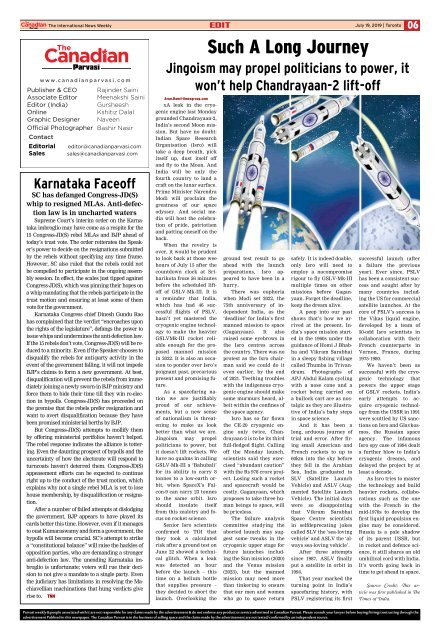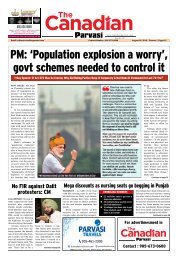You also want an ePaper? Increase the reach of your titles
YUMPU automatically turns print PDFs into web optimized ePapers that Google loves.
<strong>The</strong> International News Weekly Edit<br />
06<br />
July 19, 2019 | Toronto<br />
<strong>The</strong><br />
w w w . canadianparv asi. c o m<br />
Publisher & CEO<br />
Associate Editor<br />
Editor (India)<br />
Online<br />
Graphic Designer<br />
Official Photographer<br />
Contact<br />
Editorial<br />
Sales<br />
Rajinder Saini<br />
Meenakshi Saini<br />
Gursheesh<br />
Kshitiz Dalal<br />
Naveen<br />
Bashir Nasir<br />
editor@canadianparvasi.com<br />
sales@canadianparvasi.com<br />
Karnataka Faceoff<br />
SC has defanged Congress-JD(S)<br />
whip to resigned MLAs. Anti-defection<br />
law is in uncharted waters<br />
Supreme Court’s interim order on the Karnataka<br />
imbroglio may have come as a respite for the<br />
15 Congress-JD(S) rebel MLAs and BJP ahead of<br />
today’s trust vote. <strong>The</strong> order reiterates the Speaker’s<br />
power to decide on the resignations submitted<br />
by the rebels without specifying any time frame.<br />
However, SC also ruled that the rebels could not<br />
be compelled to participate in the ongoing assembly<br />
session. In effect, the scales just tipped against<br />
Congress-JD(S), which was pinning their hopes on<br />
a whip mandating that the rebels participate in the<br />
trust motion and ensuring at least some of them<br />
vote for the government.<br />
Karnataka Congress chief Dinesh Gundu Rao<br />
has complained that the verdict “encroaches upon<br />
the rights of the legislature”, defangs the power to<br />
issue whips and undermines the anti-defection law.<br />
If the 15 rebels don’t vote, Congress-JD(S) will be reduced<br />
to a minority. Even if the Speaker chooses to<br />
disqualify the rebels for anti-party activity in the<br />
event of the government falling, it will not impede<br />
BJP’s claims to form a new government. At best,<br />
disqualification will prevent the rebels from immediately<br />
joining a newly sworn-in BJP ministry and<br />
force them to bide their time till they win re-election<br />
in bypolls. Congress-JD(S) has proceeded on<br />
the premise that the rebels prefer resignation and<br />
want to avert disqualification because they have<br />
been promised ministerial berths by BJP.<br />
But Congress-JD(S) attempts to mollify them<br />
by offering ministerial portfolios haven’t helped.<br />
<strong>The</strong> rebel response indicates the alliance is tottering.<br />
Even the daunting prospect of bypolls and the<br />
uncertainty of how the electorate will respond to<br />
turncoats haven’t deterred them. Congress-JD(S)<br />
appeasement efforts can be expected to continue<br />
right up to the conduct of the trust motion, which<br />
explains why not a single rebel MLA is yet to lose<br />
house membership, by disqualification or resignation.<br />
After a number of failed attempts at dislodging<br />
the government, BJP appears to have played its<br />
cards better this time. However, even if it manages<br />
to oust Kumaraswamy and form a government, the<br />
bypolls will become crucial. SC’s attempt to strike<br />
a “constitutional balance” will raise the hackles of<br />
opposition parties, who are demanding a stronger<br />
anti-defection law. <strong>The</strong> unending Karnataka imbroglio<br />
is unfortunate; voters will rue their decision<br />
to not give a mandate to a single party. Even<br />
the judiciary has limitations in resolving the Machiavellian<br />
machinations that hung verdicts give<br />
rise to. TNN<br />
Such A Long Journey<br />
Jingoism may propel politicians to power, it<br />
won’t help Chandrayaan-2 lift-off<br />
Arun.Ram@timesgroup.com<br />
xA leak in the cryogenic<br />
engine last Monday<br />
grounded Chandrayaan-2,<br />
India’s second Moon mission.<br />
But have no doubt:<br />
Indian Space Research<br />
Organisation (Isro) will<br />
take a deep breath, pick<br />
itself up, dust itself off<br />
and fly to the Moon. And<br />
India will be only the<br />
fourth country to land a<br />
craft on the lunar surface.<br />
Prime Minister Narendra<br />
Modi will proclaim the<br />
greatness of our space<br />
odyssey. And social media<br />
will host the celebration<br />
of pride, patriotism<br />
and patting oneself on the<br />
back.<br />
When the revelry is<br />
over, it would be prudent<br />
to look back at those wee<br />
hours of July 15 after the<br />
countdown clock at Sriharikota<br />
froze 56 minutes<br />
before the scheduled liftoff<br />
of GSLV-Mk-III. It is<br />
a reminder that India,<br />
which has had 46 successful<br />
flights of PSLV,<br />
hasn’t yet mastered the<br />
cryogenic engine technology<br />
to make the heavier<br />
GSLVMk-III rocket reliable<br />
enough for the proposed<br />
manned mission<br />
in 2022. It is also an occasion<br />
to ponder over Isro’s<br />
poignant past, precarious<br />
present and promising future.<br />
As a spacefaring nation<br />
we are justifiably<br />
proud of our achievements,<br />
but a new sense<br />
of nationalism is threatening<br />
to make us look<br />
better than what we are.<br />
Jingoism may propel<br />
politicians to power, but<br />
it doesn’t lift rockets. We<br />
have no qualms in calling<br />
GSLV-Mk-III a ‘Bahubali’<br />
for its ability to carry 8<br />
tonnes to a low-earth orbit,<br />
when SpaceX’s Falcon-9<br />
can carry 23 tonnes<br />
to the same orbit. Isro<br />
should insulate itself<br />
from this zealotry and focus<br />
on rocket science.<br />
Senior Isro scientists<br />
confirmed to TOI that<br />
they took a calculated<br />
risk after a ground test on<br />
June 22 showed a technical<br />
glitch. When a leak<br />
was detected an hour<br />
before the launch – this<br />
time on a helium bottle<br />
that supplies pressure –<br />
they decided to abort the<br />
launch. Overlooking the<br />
ground test result to go<br />
ahead with the launch<br />
preparations, Isro appeared<br />
to have been in a<br />
hurry.<br />
<strong>The</strong>re was euphoria<br />
when Modi set 2022, the<br />
75th anniversary of independent<br />
India, as the<br />
‘deadline’ for India’s first<br />
manned mission to space<br />
(Gaganyaan). It also<br />
raised some eyebrows in<br />
the Isro centres across<br />
the country. <strong>The</strong>re was no<br />
protest as the Isro chairman<br />
said we could do it<br />
even earlier, by the end<br />
of 2021. Teething troubles<br />
with the indigenous cryogenic<br />
engine should make<br />
some murmurs heard, albeit<br />
within the confines of<br />
the space agency.<br />
Isro has so far flown<br />
the CE-20 cryogenic engine<br />
only twice, Chandrayaan-2<br />
is to be its third<br />
full-fledged flight. Calling<br />
off the Monday launch,<br />
scientists said they exercised<br />
“abundant caution”<br />
with the Rs 978 crore project.<br />
Losing such a rocket<br />
and spacecraft would be<br />
costly. Gaganyaan, which<br />
proposes to take three human<br />
beings to space, will<br />
be priceless.<br />
<strong>The</strong> failure analysis<br />
committee studying the<br />
aborted launch may suggest<br />
some tweaks in the<br />
cryogenic upper stage for<br />
future launches including<br />
the Sun mission (2020)<br />
and the Venus mission<br />
(2023), but the manned<br />
mission may need more<br />
than tinkering to ensure<br />
that our men and women<br />
who go to space return<br />
safely. It is indeed doable,<br />
only Isro will need to<br />
employ a nocompromise<br />
rigour to fly GSLV-Mk-III<br />
multiple times on other<br />
missions before Gaganyaan.<br />
Forget the deadline,<br />
keep the dream alive.<br />
A peep into our past<br />
shows that’s how we arrived<br />
at the present. India’s<br />
space mission started<br />
in the 1960s under the<br />
guidance of Homi J Bhabha<br />
and Vikram Sarabhai<br />
in a sleepy fishing village<br />
called Thumba in Trivandrum.<br />
Photographs of<br />
APJ Abdul Kalam cycling<br />
with a nose cone and a<br />
rocket being carried on<br />
a bullock cart are as nostalgic<br />
as they are illustrative<br />
of India’s baby steps<br />
in space science.<br />
And it has been a<br />
long, arduous journey of<br />
trial and error. After firing<br />
small American and<br />
French rockets to up to<br />
60km into the sky before<br />
they fell in the Arabian<br />
Sea, India graduated to<br />
SLV (Satellite Launch<br />
Vehicle) and ASLV (Augmented<br />
Satellite Launch<br />
Vehicle). <strong>The</strong> initial days<br />
were so disappointing<br />
that Vikram Sarabhai<br />
Space Centre scientists<br />
in selfdeprecating jokes<br />
called SLV the ‘sea-loving<br />
vehicle’ and ASLV the ‘always<br />
sea-loving vehicle’.<br />
After three attempts<br />
since 1987, ASLV finally<br />
put a satellite in orbit in<br />
1994.<br />
That year marked the<br />
turning point in India’s<br />
spacefaring history, with<br />
PSLV registering its first<br />
successful launch (after<br />
a failure the previous<br />
year). Ever since, PSLV<br />
has been a consistent success<br />
and sought after by<br />
many countries including<br />
the US for commercial<br />
satellite launches. At the<br />
core of PSLV’s success is<br />
the Vikas liquid engine,<br />
developed by a team of<br />
50-odd Isro scientists in<br />
collaboration with their<br />
French counterparts in<br />
Vernon, France, during<br />
1975-1980.<br />
We haven’t been as<br />
successful with the cryogenic<br />
technology that<br />
powers the upper stage<br />
of GSLV rockets. India’s<br />
early attempts to acquire<br />
cryogenic technology<br />
from the USSR in 1991<br />
were scuttled by US sanctions<br />
on Isro and Glavkosmos,<br />
the Russian space<br />
agency. <strong>The</strong> infamous<br />
Isro spy case of 1994 dealt<br />
a further blow to India’s<br />
cryogenic dreams, and<br />
delayed the project by at<br />
least a decade.<br />
As Isro tries to master<br />
the technology and build<br />
heavier rockets, collaborations<br />
such as the one<br />
with the French in the<br />
mid-1970s to develop the<br />
first liquid propulsion engine<br />
may be considered.<br />
Russia is a pale shadow<br />
of its parent USSR, but<br />
in rocket and defence science,<br />
it still shares an old<br />
umbilical cord with India.<br />
It’s worth going back in<br />
time to get ahead in space.<br />
Source Credit: This article<br />
was first published in <strong>The</strong><br />
Times of India.<br />
<strong>Parvasi</strong> weekly & people associated with it are not responsible for any claims made by the advertisement & do not endorse any product or service advertised in <strong>Canadian</strong> <strong>Parvasi</strong>. Please consult your lawyer before buying/hiring/contracting through the<br />
advertisement Publised in this newspaper. <strong>The</strong> <strong>Canadian</strong> <strong>Parvasi</strong> is in the business of selling space and the clains made by the advertisement are not tested/confirmed by an independent source.
















